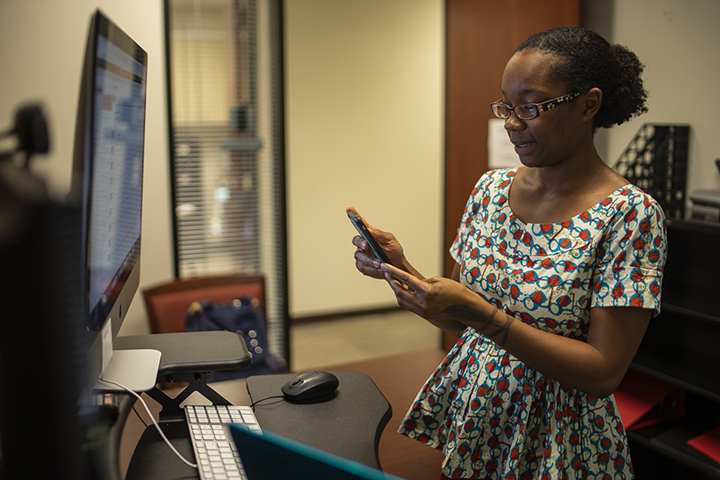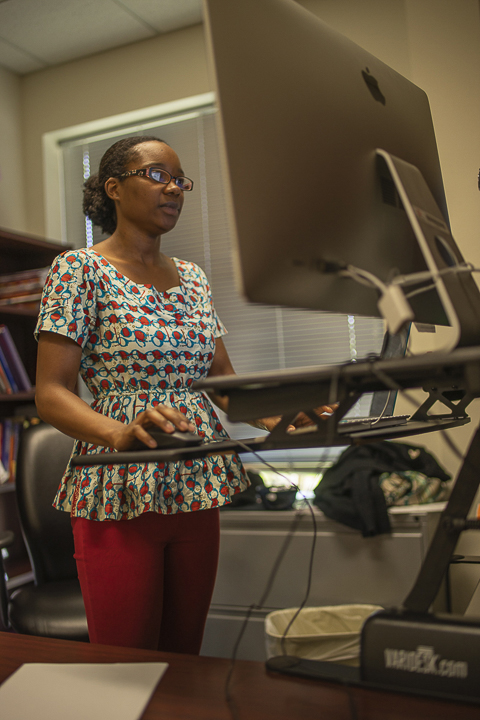
Silence is an attribute the hearing world places on the deaf world. However, students are often challenged with a different form of silence that may not be recognized.
Gloshanda Lawyer, assistant professor in the department of deaf studies and deaf education, is researching social justice for deaf students.
“I focus on multiply-marginalized deaf people — deaf people of color who are also LGBTQI, who also come from families that don’t speak English, who immigrated to this country — that’s more of my focus area,” she said.
One of Lawyer’s goals is promoting what she calls “language justice,” the concept of education that includes sign language in both the student’s home language and ASL, as well as written English.

Gloshanda Lawyer, explains that sometimes she uses up to
four different screens to during her work day in her office in the communications building, March 27. UP photo by Noah Dawlearn
“Access justice” is another aspect of her research, because deaf students face additional challenges beyond simply enrolling in classes.
“Do they have access to interpreters, what kind of barriers are they facing when they are trying to pursue higher education?” she said. “Then I also do work on ‘translanguaging,’ which is basically honoring students’ languages and (the) backgrounds they bring, even if it’s not standard English.”
Lawyer started writing about the issues as an undergraduate, and turned to academic research during her doctoral program about four years ago.
“Before that, I was a classroom teacher in a deaf school,” she said. “Most of our students were students of color, either from Somalia or from different Spanish-speaking countries. I started out making sure IEP — individualized education plans — were translated into the home language, so the parents could actually read them when they are signing them.”
The school offered ASL classes for parents, but Lawyer was part of an effort to create a separate class just for Spanish-speaking parents.
“We had a deaf teacher who was teaching Spanish-speaking families, and instead of English to ASL, we provided Spanish to ASL,” she said. “It started out with little things like that and then it moved to formal research.”
Lawyer’s dissertation research focused on interviewing 25 multiply-marginalized deaf adults about their school experiences in the U.S.
“Some came from K-12 schools, some of them immigrated here only to go to college, and some came in high school,” she said. “It was about the experiences of school here. What I found was that school is a place where most of, if not all of them, felt oppressed.
“They felt that school was the place where they are conditioned to be less. They are conditioned to accept, ‘Oh, you are deaf, so you can’t.’”
The students told Lawyer they felt the teachers and interpreters, especially, were not there for the students, that they were there for their own self-serving reasons.
“Or they are there to make us as hearing as possible — to not be deaf,” she said. “A lot of them said, because of all of those experiences, ‘I didn’t discover my identity until college. And college was where I had to wrestle with the fact that I’m deaf, I’m a person of color, and I use this language that for most of my life, I was denied access to.’”
Lawyer’s dissertation is being translated into ASL.
“I’m trying to produce it in American Sign Language first,” she said. “That was one of the biggest requests from all of the people who contributed to my study. They said, ‘Most of us have participated in research, but every time we do, it’s always for the hearing people, it’s always produced in English. Where is it in ASL for us?’
“That was one of the commitments I made to them, if this will be available in American Sign Language. Which is a work in of itself, because I am translating 300 documents into ASL.”
Lawyer said she is recruiting diverse deaf people to represent the stories in her dissertation. She finished her research in August, and her goal is to complete the video translation within the next year.
Lawyer is currently researching trilingual interpreters and their experiences.
“We have statistics that say 50 percent of deaf individuals are people of color and 25 percent of that total are from Spanish-speaking backgrounds,” she said. “So if we don’t have interpreters who know Spanish, English and American Sign Language, how are we fully serving those communities?”
Lawyer has interviewed 12 interpreters so far.
“(There’s) not a huge pool of trilingual interpreters in the United States,” she said. “Basically, there’s not enough training programs for trilingual interpreters, because the interpreter programs are designed for people who grew up knowing one language. They come into college learning a second language and then (they) become interpreters for that language as well.
“It’s not for people who grew up with two languages and they’re trying (to learn) to interpret.”
Lawyer recently gave a presentation at a conference in Chicago about bilingual pedagogy and social justice.
“We have future teachers and future interpreters examine their own privileges as people who can hear, people who can see, people who don’t always match the identities of the deaf individuals,” she said. “What kind of privileges do you have going into the classroom, and how does it impact your teaching and interpreting?”
“We have (teachers and interpreters) do reflections on that. Then in our classroom PowerPoints and lectures, we have social justice pauses — so any time we touched on a topic, say you’re teaching math, how are you also empowering students? We know that girls, for example, are not readily supported in STEM areas, so in math class, are you picking on the boys all the time or are you also reinforcing the girls? Then suppose it’s literacy time, are you picking books that represent people with disabilities as much as you’re picking other books?”
It’s about getting teachers to be more conscious of students who may be different than them, Lawyer said.
“For their lesson plans in their classroom observations, they had to intentionally cite how social justice is being applied in this context,” she said. “If I’m planning for a lesson, what am I specifically, intentionally doing that’s social justice related within my lesson? If I’m observing a teacher, where do I see opportunities where they could have addressed a social justice issue with their students? That’s a practical issue.”
Lamar University teaches a bilingual program, and Lawyer’s alma mater at The University of Tennessee-Knoxville is a fully bilingual education now, as a result of her doctoral research.
“That’s one more university that’s teaching bilingual like we are here at Lamar,” she said.
Lawyer said she works with future teachers in her Lamar classes.
“I developed a framework called a decolonizing-intersectionality framework, which basically talks about teaching and research and how you teach to decolonize students and yourself, how you’re always applying an intersectional lens to your teaching,” she said. “Immigrants, language, race, ethnicity, socioeconomic status — all of those things encompass one individual. How are you addressing that in your classroom?”
Lawyer grew up in what the field of linguistics would consider to be a multilingual household. She grew up with Spanish and English as formal languages, but she also spoke Gullah Geechee, which is a Creole-based dialect of English specific to African Americans in South Carolina and Georgia.
“And then I learned American Sign Language,” she said. “Now I also use Black American Sign Language, which is a different dialect of ASL, and I’m learning protactile, which is a tactile language for deaf blind people. Then I speak Sierra Leone Creole as well as Portuguese. My partner’s first language is Portuguese, so we also have Portuguese in our home.”
Lawyer said her three-year-old daughter is exposed to all of these languages.
“If you ever come to our house, it’s just like language is everywhere,” she said.
As a black woman, Lawyer said she believes women are always finding new ways to navigate a male-dominated system.
“Even if it’s not all run by males, the system is structured to support that,” she said. “The system is not made for us. But we still find ways to function in it, we still find ways to excel in it.”
Lawyer said she and several other black women in academics at Lamar have formed a support group.
“I think it’s important for us to celebrate the daily victories that we have, especially among each other, even if it’s not recognized anywhere else,” she said. “Just to know, ‘OK, as a woman, I see you, I recognize you. Keep fighting.’
“I think that’s the biggest thing, because I think we sometimes feel really alone.”
Lawyer is making sure marginalized communities — both deaf and hearing — are not alone.
